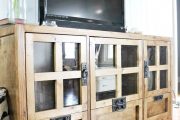Owning a home can sometimes feel like a never-ending struggle to keep things running smoothly and in good shape. Especially with summer coming up, you’re probably thinking about taking some time to work on things in and around your house. While these tips won’t substitute for assistance from a qualified professional if necessary, you can still save yourself money and trouble down the road by being proactive.
– Check for air leaks in your windows and doors. Over time as your house settles, it can pull the window or door frames out of alignment slightly, forming gaps in the seams that can allow air leaks and cause drafts. Air leaks can make your air conditioner or furnace work less efficiently, translating into higher energy costs. A simple but effective way to check for air leaks is to make sure all windows and doors are closed in your house, then use a stick of incense or a candle to check for any air leaks in the area of windows or doors. Any leaking doors or windows should have the seams recaulked if necessary.
– Inspect your foundation. The major cause of many foundation problems is often attributed to moisture causing the soil to shift under the foundation, causing the foundation to rise or sink, which can lead to cracking, water leaks in your home or even significant structural damage. Keep an eye out for any cracks in the exposed area just above ground level or areas where the soil has dried and pulled away from the foundation. For homeowners in areas going through a significantly hot and dry period, you may wish to look into watering the foundation as a preventative measure against foundation damage. Additionally, be sure that the soil around the foundation is sloped downwards away from your home – this will help channel excess rainwater away from the house rather than allowing it to seep underneath the foundation.
– Replace the light bulbs in your home. If you’re still using incandescent bulbs for lighting in your home, consider replacing them gradually with CFLs. Although CFLs are still pricey compared to incandescent bulbs, they offer the advantage of both a greatly extended lifetime but also reduced energy usage while still outputting a comparable amount of light.
– Maintain the garage door. The garage door generally won’t need a huge amount of maintenance to keep it in good shape over its lifespan but the few moving parts attached to it are generally a different story. They can be prone to wearing out or working loose over time. For the best results, lubricate the springs, cables, rollers and hinges with WD-40 or a similar product and inspect any bolts or other fasteners on the garage door to ensure that they are tight. If you have a garage door opener, check that the safety sensors on either side of the garage door are not dusty or misaligned as this can cause the opener to malfunction. It is also highly advisable that you test the safety sensors by placing a board in the path of the garage door – the garage door opener should immediately reverse the garage door upon encountering an obstruction.
– Trim back your landscaping. This one may be an ongoing project but it can save you some trouble down the road. Keeping your shrubs, trees and any other plants next to your house trimmed away from the exterior of the house is always a wise idea. It prevents the foliage from trapping moisture against the walls of your home, which can cause deterioration in the paint, siding or other materials you may have on the exterior of your house.
– Clean your gutters. This can get overlooked very easily since you may not be able to see the gutters from ground level, but it’s always important to keep your gutters clean. The dead leaves and other debris can cause the gutter to overflow onto the roof, potentially allowing water to seep under the roofing and cause a leak. Any dead leaves or other debris piled on the roof itself should be removed if possible as these can harbor moisture underneath and cause the shingles to deteriorate.
– The plumbing is another area where you can make some simple yet effective updates. Dial the water heater down to 120 degrees if it’s set at the standard 140 degrees – this will still generate sufficiently hot water for washing dishes and clothes or bathing. The water heater and the exposed pipes connected to it can be insulated, reducing the amount of heat lost from the water heater and reducing your energy costs as a result.
Justin Krutz writes about home improvement and assorted related topics for Palatin Remodeling, Inc., a company specializing in Los Angeles bathroom remodeling and kitchen remodeling services.

![Save money and energy with this home improvement project [Infographic]](https://homeimprovementblogs.com/hg-blog/wp-content/themes/mts_sensational/images/nothumb-sensational-related.png)